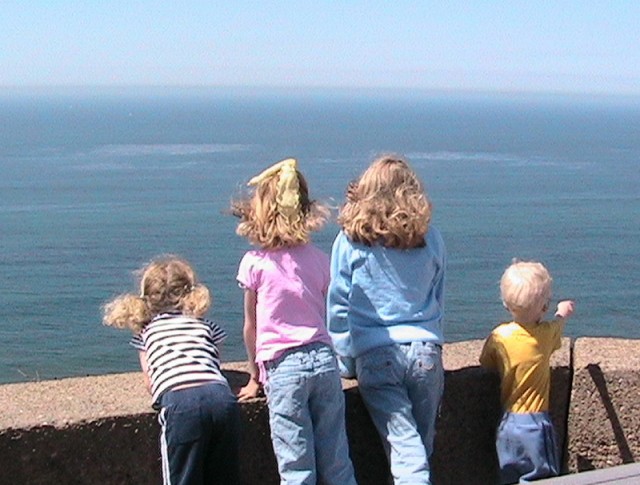What is Tidal Homeschooling?
“Tidal homeschooling” is a term I coined in 2006 to describe my family’s home education style. We are not quite unschoolers but are heavily influenced by unschooling ideas and principles, especially the emphasis on relationship and joy in family life, and the belief that, as John Holt put it, human beings are learning all the time—and not necessarily in a classroom or with items labeled curricula.
But our lifestyle and learning methods were also informed by writers like Charlotte Mason, who advocated for a childhood filled with excellent literature, nature study, narration, art, music, foreign language, and handcrafts. Mason devised a highly structured educational program designed to deliver these riches in such a way that students would hold on to them forever. And just as my family aren’t quite unschoolers (according to the somewhat tighter definition that came to be attached to the word during the first decade of this century), we also aren’t full-on Charlotte Mason folks, either. I’ve drawn much from Miss Mason’s ideas (and ideals), and I’m a champion of narration and other Mason touchstones, but I do not follow a strict and complete CM program with my kids—despite Miss Mason’s cautions in Volume 6 of her homeschooling series against that very thing! She urges her readers to understand that her method is meant to be adopted wholly and completely, not in bits and pieces. Well, when it comes to CM, I’m unabashedly a bits-and-pieces person, and the posts linked here will explain why.
I coined the ‘tidal’ metaphor to describe how learning and living actually happens in my home. It’s not a method, it’s a description. Here’s how I explained it back in 2006:
The truth is, I couldn’t find any label that completely fit my family, so I made up my own. I call us “Tidal Learners” because the ways in which we approach education here change with the tide. Now, this doesn’t mean that we’re flighty or inconsistent, changing direction haphazardly. We aren’t Fiddler Crab Homeschoolers. What I mean is that there is a rhythm to the way learning happens here; there are upbeats and downbeats; there is an ebb and flow.
We have high tide times when I charter a boat and we set sail with purpose and direction, deliberately casting our net for a particular type of fish. On these excursions I am the captain; I have charted the course. But the children are eager crew members because they know I value their contributions. And also I provide generous rations. No stale or moldy bread on this ship: no dull textbooks, no dry workbooks. My sailors sink their teeth into fresh, hearty bread slathered with rich butter and tart-sweet jam. Well fed and proud of their work, my little crew exhilarates in the voyage. Every journey is an adventure.
And we have low tide times when we amble along the shore, peering into tide pools and digging in the sand, or just relaxing under beach umbrella. The children wander off in directions of their own choosing; they dig and poke and ponder. One of them may crouch over a rock pool and stay there for days, studying, watching. Another will run headlong into the waves, thrilling to the pull on her legs, splashing, leaping, diving under and emerging triumphantly farther out. Or a child might prefer to stay close by my side, drawing stick pictures in the sand or building a castle. All of these things may be happening at once. Sometimes it looks as though nothing is happening: there’s just an array of bodies on beach towels. But oh, the nourishment there is in a time of quiet reflection while the soul soaks up the sunlight!
Our family enjoys both kinds of learning—the heady adventure of the well-planned fishing trip, with a goal and a destination in mind, and the mellower joys of undirected discovery during weeks at the metaphorical beach. Around here, the low tide times happen much more often than the high tide times, and often I find that the children catch more fish, so to speak, when the tide is out. Beachcombing reveals many treasures. But they do enjoy their excursions with Cap’n Mom. I really believe joy is the key, the element we breathe whether the tide is in or out. It’s the wind that propels our ship; it’s the tangy breeze that cools and refreshes us on the beach.
I was 37 years old then, with four children under 10 and a great deal of energy. I’m 45 now, with six children ages 5-18, and I have to smile a little at my highflown words. The language is lofty but the idea holds true. We have continued to ebb and flow between periods of “high tide” times of structured learning (in which the kids, particularly the teenagers, have a great deal of involvement in choosing a course of study) and “low tide,” which looks a lot like unschooling. The description still fits; the pattern still works for us.
A collection of my posts about tidal homeschooling
(My favorite kinds of posts are in the Connections category.)
Updated January 2023: you’ll find recent posts about what tidal homeschooling looks like for teens at the top of this tag.
A 2016 interview on the Ed Snapshots podcast
What the Tide Brought In (and Carried Out, and Brought Back In)
Accidental vs. On-Purpose Learning
Lovely, Lovely Low Tide (a follow-up to this post about connections)
Radical Unschooling, Unschooling, Tidal Homeschooling, and the Wearing of Shoes that Fit
Can you tell I really love low tide? LOL!
This post isn’t about tidal homeschooling per se, but it gives a good picture of the flavor of our high-tide days: All Roads Lead to Rome (Even for Bunnies)
My Amazon bookshop contains many of the books we’ve loved in all tides over the years. Any purchases made via this portal will earn me a small referral fee that help pays for the maintenance of this site. Thanks!

